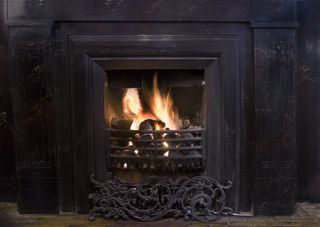
by blogediter | Aug 13, 2018 | Fireplaces
Fire Place
Q: Hi Jason, Is it easy to remove the Chimney Balloon. I have a gas fireplace with a warped damper. We use sometimes in winter. Would the Chimney Balloon be easy to remove and put back in for fires? – KN
A: Dear KN, Your questions are very common for Chimney Balloon users, and I can answer it from my own experience with our living room fireplace as well. Uninstalling and installing the Chimney Balloon in smaller gas log Fireplaces is really very easy so it doesn’t hinder your ability to use the fireplace seasonally at all. The first install usually has a bit of a learning curve to it, but once you do the install you will have a method down pat on how to do it again.
Personally, I have found using the Chimney Balloon has me clustering my fireplace uses in the winter. For instance…I will tell my kids and wife that when we put up the Christmas tree I will uninstall the Chimney Balloon and we will enjoy using our fireplace for those festive weeks before the holidays come, and I will just use the old damper during those weeks. After New Years the tree comes down and the Chimney Balloon gets reinstalled in the fireplace, and then I know it is sealed up tight again. This allows everybody to get their fireplace fix for the year, and I am only doing one install and uninstall. Sure the living room is a little draftier during that time when the Chimney Balloon is out, but it also helps me appreciate the difference when the Chimney Balloon is installed and saving me on the heating bills.
I hope this answers your question KN. Let me know if I can help further. – Jason
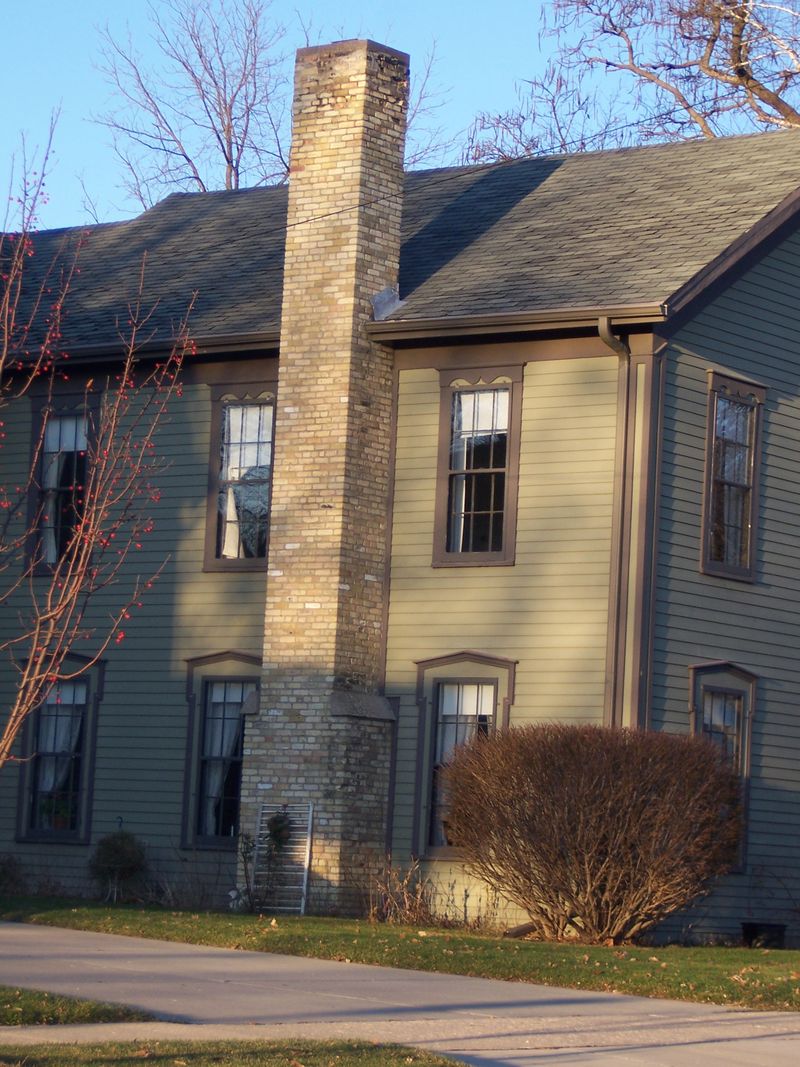
by blogediter | Aug 6, 2018 | Fireplaces, Chimney Problems
Fall and Winter
Q: When I light my wood burning fireplace, my gas furnace pilot light on the other side of the house blows out. How do I stop this? – ST
A: Dear ST, Well without actually seeing this particular situation in action it is hard to tell. Two major questions are: How old is the furnace, is this an open fireplace or enclosed fireplace?
If I had to take an educated guess…I would say that the stack effect in your home is rather strong, and the draft is accelerated through your furnace when you light the fireplace and this is blowing out the furnace pilot light.
When you open your fireplace damper there is heated inside air immediately rising out of the chimney. As you light and stoke a fire the volume of air escaping your house through the chimney is higher and higher. That is why heating with an open fireplace is a losing battle. Since your home has to take in air in other areas to replace the air it is loosing out the flue, your normal drafts in your house (around baseboards, outlets, doors, windows & furnace flues) are under pressure to allow in more and colder outside air. This type of increased draft could be what is blowing out your furnace pilot light.
This has the potential to be a dangerous situation so you will want to have an HVAC tech over to check the furnace draw during the fireplace use. – Jason
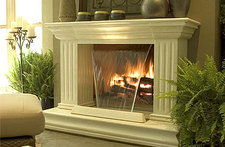
by blogediter | May 24, 2018 | Fireplaces
Hearth Falls
When I first heard of the Fireplace waterfalls on Fireplace Lowdown Blog I knew I had to write something on these beautiful living room pieces of art.
Unfortunately, it has come to our attention through this blog article that Hearth Falls has had some serious issues. If you have experienced these issues you are welcome to contact Duayne at the Attorney Generals Office in Littlerock, Arkansas. They apparently are handling this case.
A photo is provided by Hearthfalls.com. Copyright ownership belongs to Hearthfalls.com
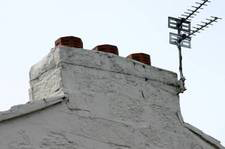
by blogediter | May 2, 2018 | Fireplaces
Three Chimneys
Q: Jason – I have two fireplaces in my home, one in the living room and one in the basement. When I light one fireplace the other one gets smoky. My fireplace shop said to crack a window so this wouldn’t happen, but it is -1 degrees F out, who wants to open a window when it is so cold?! Why would that help keep the smoke out? – KM
A: KM – You are experiencing a very common problem among new homes with multiple fireplaces. Let’s look at this in sections
1) Your fireplace sucks air when lit.
When you light one fireplace that fire starts drawing air from the rest of the house like a vacuum for the combustion process. To replace that air the house will start drawing in outside air through the path of least resistance in order to equalize the pressure. This is called the “stack effect”. Your home could draw this air through worn weatherstripping, power outlets on outside walls, cracks, under insulated windows, or many other ways. One of the weakest points in a homes air envelope seal is the metal fireplace damper. In you case your home is pretty tight but your fireplace damper is the path of least resistance for cold air to gain entry. See the image below of 3 chimneys that are too close together, they may draw smoke from each other.
2) Your fireplace damper is weak and is the easiest way for cold outside air to gain entrance.
When the air is drawn down the chimney to equalize the pressure in your home it also draws down the smoke that is wafting around your roof. This is why your basement gets smoky.
3) Seal your basement damper.
If you seal up the basement damper and flue with a Chimney Balloon it will then be air tight and will not draw in smoke.
4) Your home cannot be a vacuum.
When you burn in your fireplace your home will continue to draw in air from the outside. It just wont be drawing smoky air from your roof. But it will draw from somewhere. That is why burning in your fireplace does not save you on heat, it actually costs you heat in most situations.
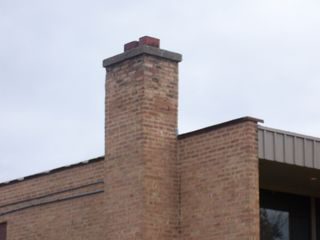
by blogediter | Apr 25, 2018 | Fireplaces
Smoke goes up the one chimney and back down the other.
Q: I have a house built in 1870, and the flue I would like to seal appears to be very narrow, somewhat jagged, and irregular in shape. The best I can tell, the opening appears to be about 6 inches deep, and 12 inches wide. Which size would be best for me? And do you think there is a wider opening further up the chimney? If so, would I be able to push the Chimney Balloon up there and then inflate it??
Also, like Maureen in the previous post, I have a smoke situation and am hoping your product will help. We have multiple fireplaces, and when I burn a fire in the living room downstairs, smoke enters my son’s bedroom upstairs. They are in the same chimney. This started happening after we added a chimney cap to keep birds and animals out. The guy who did the work came back and claims he sealed the flue heading into the boy’s bedroom. But we had one more fire at the end of last season and still smelled smoke in his room during the fire downstairs. Please advise… – JW
A: Dear JW, Well, to answer your first question… I would go with a 9×15 Chimney Balloon for that size hole to plug. It does not matter much if the hole is jagged and rough in shape as long as the hole is not any larger than 9″x15″ and has roughly parallel walls on at least 2 sides.
On your smoke crossover question…Yes, the Chimney Balloon will give you a very tight seal on your unused chimney so the smoke smell will not be sucked back into the home. I’m sure your Chimney sweep gave it a good try to seal it up, but there is no way to get as tight of a seal as a Chimney Balloon will offer. Even a fiberglass bat plug will allow odor back in through it. – Jason
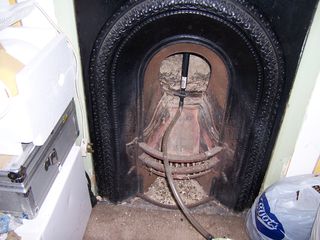
by blogediter | Apr 23, 2018 | Chimney Plugs, Fireplaces
Air seal a small coal burner fireplace
Q: I have an old coal fireplace, with a cast iron insert. The chimney itself has no damper but the insert does have a narrow flap that I suppose is used as a damper (though a very inefficient one when it the fireplace is not in use). I had to slide the insert out to see what the chimney looks like from the inside, as there was no way to see through the damper slot (which measure about 20″x2″).
The highest and narrowest part of the chimney is 9″x9″. Then it looks like it’s relatively straight/slightly sloping at about 9″x15″. And then slopes again over about 20″ to it’s the largest point of 9″x20″, just above that damper slot in the insert.
From what I’ve read, you don’t recommend positioning the Chimney Balloon on the slope. I’m almost positive I wouldn’t be able to get the Chimney Balloon up to the 9×9 spot (certainly not without removing the insert every time, which I want to avoid).
So, a bunch of questions:
1. What’s the likelihood of me being able to maneuver the Chimney Balloon through the damper slot in the insert?
2. What’s my best position?
3. Related to #2, what’s my best sizing?
4. Oh, and I think the 9″ is really more like 9.25… how exactly are you Chimney Balloon sizes?
Thanks for your help! – ZE
A: Dear ZE, We spoke on the phone briefly about how your coal inserts slide into the fireplace. Considering there is significant clearance between the top of the insert and the 9×9 fireplace flue area, you will find the 9×15 area to be the best location to install the Chimney Balloon. I understand the walls of this area taper upward on two sides and are vertical on two sides in this area. The Chimney Balloon will grab and hold firm on the two parallel and vertical walls, and it will seal the two slanted walls as well.
Once in place, it is possible to uninstall the Chimney Balloon through the very small 2″ damper opening, but honestly, it is not easy to do. You will have to reach the Chimney Balloon through the damper so you can open the air valve. Once the air valve is open you will have to give the Chimney Balloon 5 minutes or more to release its air. Then you slowly and carefully thread it down through the damper little by little. Fortunately, a 9×15 is a relatively small Chimney Balloon, so there is not a lot of Chimney Balloon material.
If I can be of further assistance to you in this coal fireplace insert application please let me know. – Jason





